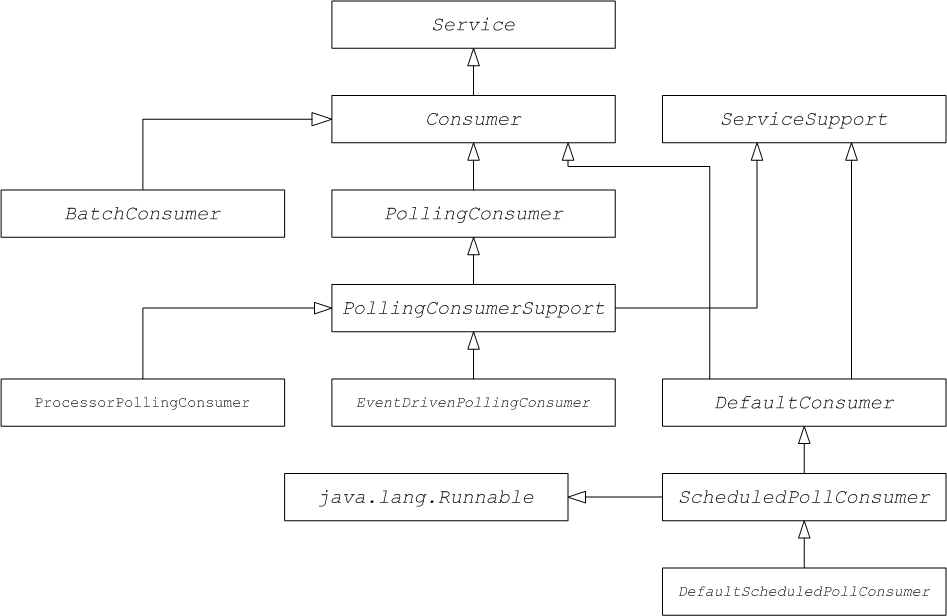An instance of org.apache.camel.Consumer type represents
a source endpoint in a route. There are several different ways of implementing a consumer
(see Consumer Patterns and Threading), and this degree of
flexibility is reflected in the inheritance hierarchy ( see Figure 8.1), which includes several different base
classes for implementing a consumer.
For consumers that follow the scheduled poll pattern (see Scheduled poll
pattern), Fuse Mediation Router provides support for
injecting parameters into consumer instances. For example, consider the following endpoint
URI for a component identified by the custom prefix:
custom:destination?consumer.myConsumerParam
Fuse Mediation Router provides support for automatically injecting query options of the form
consumer.*. For the consumer.myConsumerParam parameter, you need
to define corresponding setter and getter methods on the
Consumer implementation class as follows:
public class CustomConsumer extends ScheduledPollConsumer {
...
String getMyConsumerParam() { ... }
void setMyConsumerParam(String s) { ... }
...
}Where the getter and setter methods follow the usual Java bean conventions (including capitalizing the first letter of the property name).
In addition to defining the bean methods in your Consumer implementation, you must also
remember to call the configureConsumer() method in the
implementation of Endpoint.createConsumer(). See Scheduled poll
endpoint implementation). Example 8.1 shows an example of a
createConsumer() method implementation, taken from the
FileEndpoint class in the file component:
Example 8.1. FileEndpoint createConsumer() Implementation
...
public class FileEndpoint extends ScheduledPollEndpoint {
...
public Consumer createConsumer(Processor processor) throws Exception {
Consumer result = new FileConsumer(this, processor);
configureConsumer(result);
return result;
}
...
}At run time, consumer parameter injection works as follows:
When the endpoint is created, the default implementation of
DefaultComponent.createEndpoint(String uri)parses the URI to extract the consumer parameters, and stores them in the endpoint instance by callingScheduledPollEndpoint.configureProperties().When
createConsumer()is called, the method implementation callsconfigureConsumer()to inject the consumer parameters (see Example 8.1).The
configureConsumer()method uses Java reflection to call the setter methods whose names match the relevant options after theconsumer.prefix has been stripped off.
A consumer that follows the scheduled poll pattern automatically supports the consumer parameters shown in Table 8.1 (which can appear as query options in the endpoint URI).
Table 8.1. Scheduled Poll Parameters
| Name | Default | Description |
|---|---|---|
initialDelay | 1000 | Delay, in milliseconds, before the first poll. |
delay | 500 | Depends on the value of the useFixedDelay flag (time unit is
milliseconds). |
useFixedDelay | false |
If If |
Fuse Mediation Router provides two special consumer implementations which can be used to convert back and forth between an event-driven consumer and a polling consumer. The following conversion classes are provided:
org.apache.camel.impl.EventDrivenPollingConsumer—Converts an event-driven consumer into a polling consumer instance.org.apache.camel.impl.DefaultScheduledPollConsumer—Converts a polling consumer into an event-driven consumer instance.
In practice, these classes are used to simplify the task of implementing an
Endpoint type. The Endpoint
interface defines the following two methods for creating a consumer instance:
package org.apache.camel;
public interface Endpoint {
...
Consumer createConsumer(Processor processor) throws Exception;
PollingConsumer createPollingConsumer() throws Exception;
}createConsumer() returns an event-driven consumer and
createPollingConsumer() returns a polling consumer. You would
only implement one these methods. For example, if you are following the event-driven pattern
for your consumer, you would implement the createConsumer() method
provide a method implementation for createPollingConsumer() that
simply raises an exception. With the help of the conversion classes, however, Fuse Mediation Router is
able to provide a more useful default implementation.
For example, if you want to implement your consumer according to the event-driven
pattern, you implement the endpoint by extending DefaultEndpoint and
implementing the createConsumer() method. The implementation of
createPollingConsumer() is inherited from
DefaultEndpoint, where it is defined as follows:
public PollingConsumer<E> createPollingConsumer() throws Exception {
return new EventDrivenPollingConsumer<E>(this);
}The EventDrivenPollingConsumer constructor takes a reference to
the event-driven consumer, this, effectively wrapping it and converting it into
a polling consumer. To implement the conversion, the EventDrivenPollingConsumer
instance buffers incoming events and makes them available on demand through the
receive(), the receive(long timeout),
and the receiveNoWait() methods.
Analogously, if you are implementing your consumer according to the polling pattern, you
implement the endpoint by extending DefaultPollingEndpoint and
implementing the createPollingConsumer() method. In this case, the
implementation of the createConsumer() method is inherited from
DefaultPollingEndpoint, and the default implementation returns a
DefaultScheduledPollConsumer instance (which converts the polling
consumer into an event-driven consumer).
Consumer classes can optionally implement the
org.apache.camel.spi.ShutdownAware interface, which interacts with the
graceful shutdown mechanism, enabling a consumer to ask for extra time to shut down. This is
typically needed for components such as SEDA, which can have pending exchanges stored in an
internal queue. Normally, you would want to process all of the exchanges in the queue before
shutting down the SEDA consumer.
Example 8.2 shows the definition of the
ShutdownAware interface.
Example 8.2. ShutdownAware Interface
// Java
package org.apache.camel.spi;
import org.apache.camel.ShutdownRunningTask;
public interface ShutdownAware {
boolean deferShutdown(ShutdownRunningTask shutdownRunningTask);
int getPendingExchangesSize();
}The ShutdownAware interface defines the following methods:
deferShutdownReturn
truefrom this method, if you want to delay shutdown of the consumer. TheshutdownRunningTaskargument is anenumwhich can take either of the following values:ShutdownRunningTask.CompleteCurrentTaskOnly—finish processing the exchanges that are currently being processed by the consumer's thread pool, but do not attempt to process any more exchanges than that.ShutdownRunningTask.CompleteAllTasks—process all of the pending exchanges. For example, in the case of the SEDA component, the consumer would process all of the exchanges from its incoming queue.
getPendingExchangesSizeIndicates how many exchanges remain to be processed by the consumer. A zero value indicates that processing is finished and the consumer can be shut down.
For an example of how to define the ShutdownAware methods, see Example 8.6.









